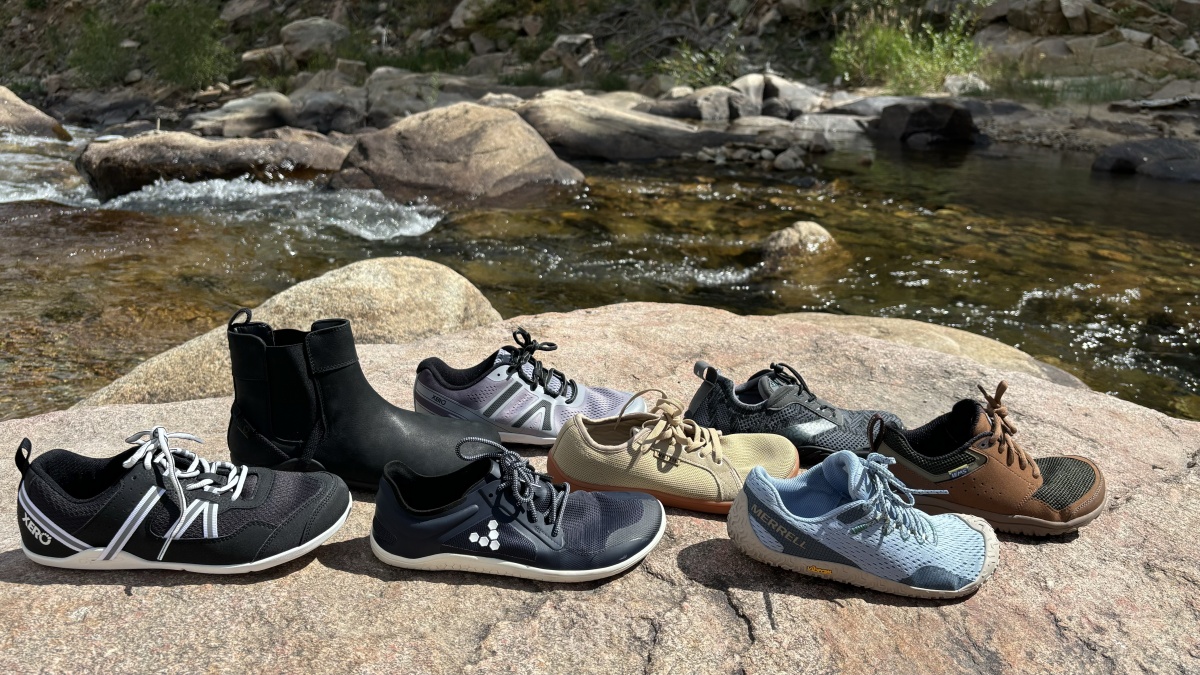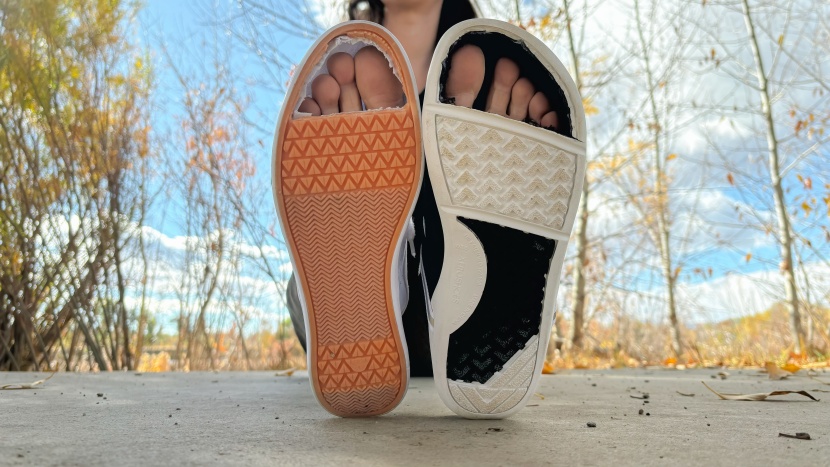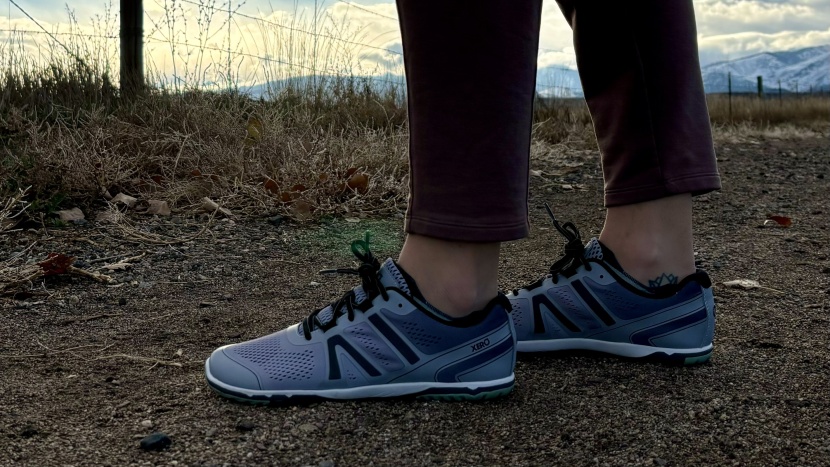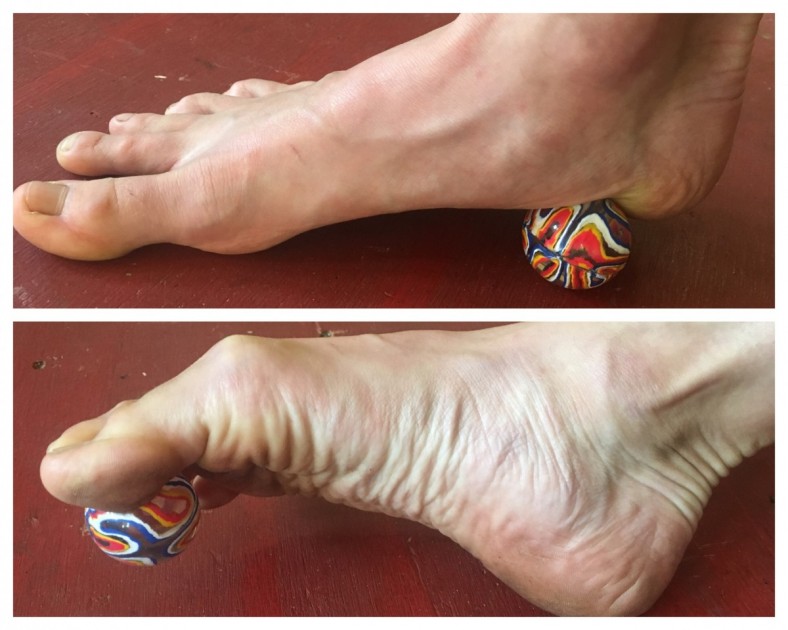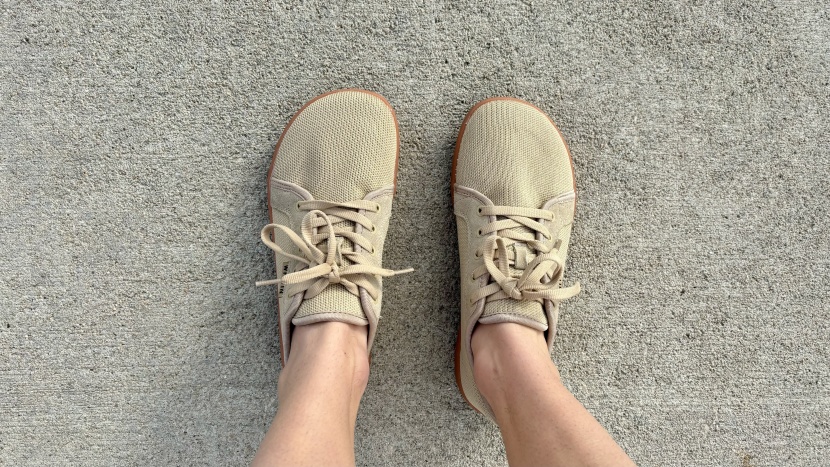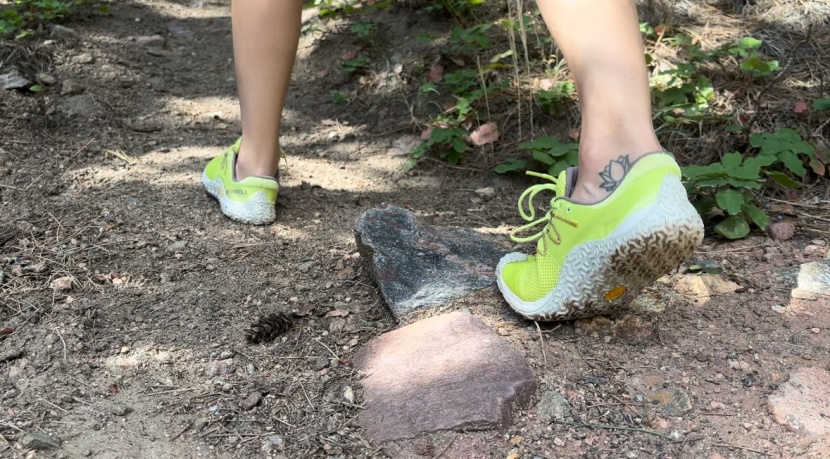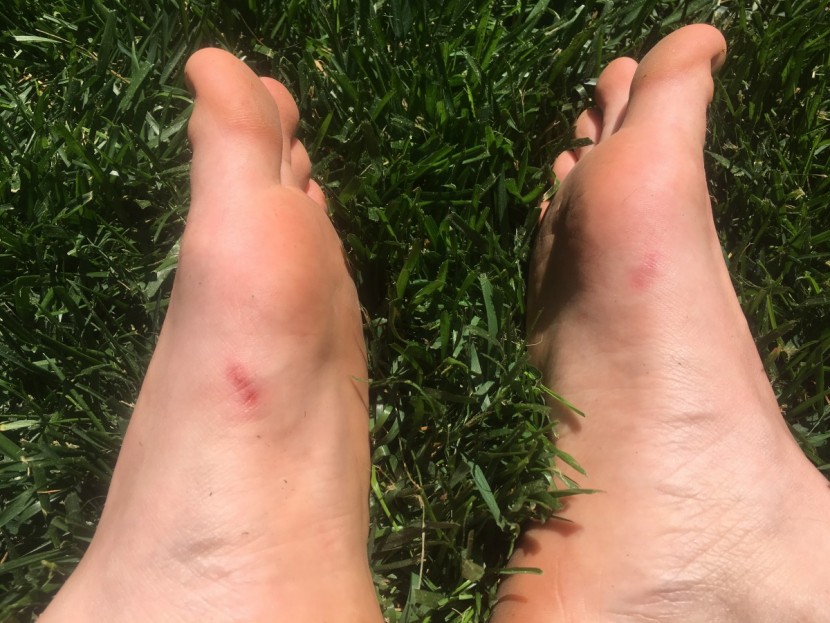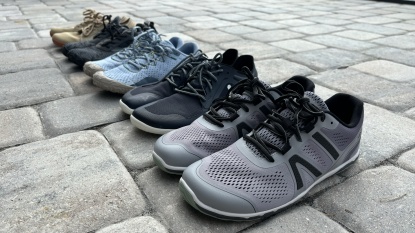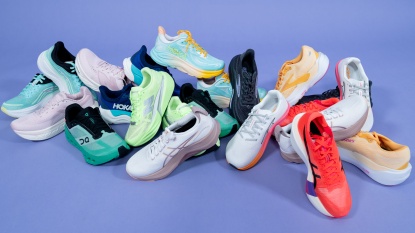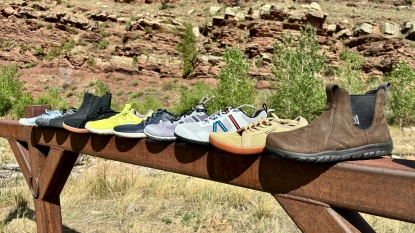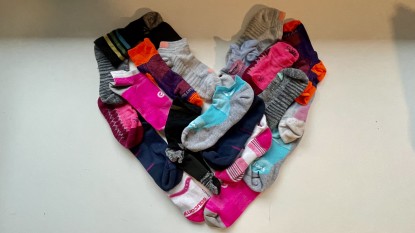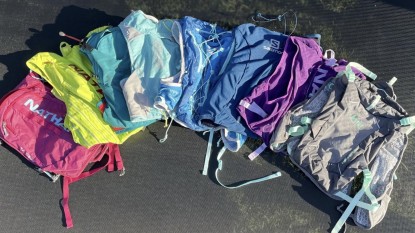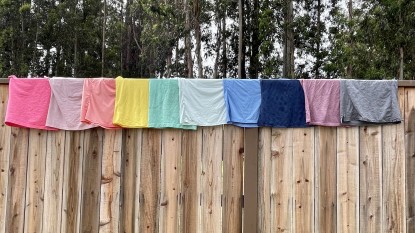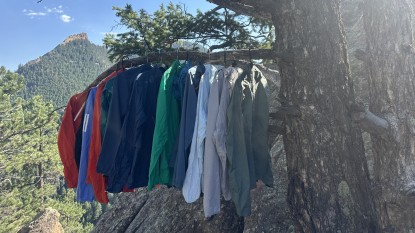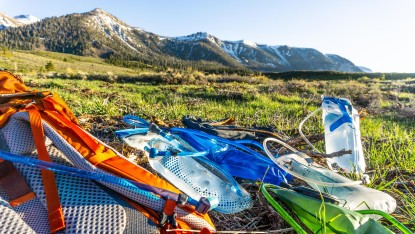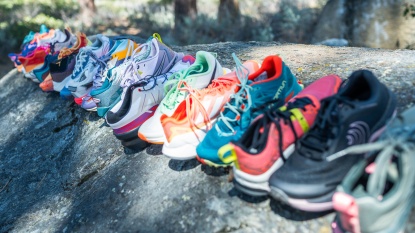- Get the shoe out of the way so you can enjoy improved foot proprioception (the ability to sense stimuli, in this case through thinner soles)
- Rebuild lower leg strength because the shoe isn't doing any gait motion control (and only if you do so carefully and intentionally)
- Improve overall running gait and posture by giving yourself nearly natural “feetback” from the minimal shoe on your foot
At least, that's the ideal…
The catch is that this may best be done actually barefoot, and requires a whole lot of self-awareness and monitoring and attention to ensure the transition to minimalist footwear goes well (see the next section for a primer on how to transition while minimizing your risk for injury). For some, these shoes may simply be a way to reduce losses to foot proprioception, strength, and movement patterns when you are forced to wear shoes (due to inclement weather, terrain, working in an office, etc.)
Remember that it is always important to listen carefully to your body. Research continues to investigate this interesting subject, and it will continue to evolve. Seriously consider hiring a running coach to help you improve your gait and running economy, with or without minimalist footwear. Many athletes run injury-free in what we now consider “normal” running shoes (those with more cushion, arch support, heel drop, and motion control) because they have excellent form.
It is important to note that shoe manufacturers are not claiming that their barefoot/minimal shoes will increase your stability. A lot of research would need to be done to claim that. It is for this reason that some experts actually recommend starting from scratch and going fully barefoot, slowly and carefully, and then using these minimal shoes as a tool for the times you can't run completely unshod.
Design Characteristics of a Minimalist Shoe
First, some definitions: Just what are the attributes of a shoe that make it so minimal it's almost like running barefoot? The first attribute seems obvious: a very thin sole. The sole should be less than 10-15mm thick.
Zero Drop
Zero drop has become somewhat of a catchphrase in shoe lingo these days. It means that the thickness of the sole under your heel is the same as the thickness under your toes. Imagine an extreme example: High heels. Over time, if you wear shoes with elevated heels often, the muscles and connective tissues of the back of your legs will tighten up. This can have a variety of cascading effects on the balance (or imbalance) of all of your muscles, and rarely are these effects good. Proponents of the steep heel-to-toe drop in athletic footwear have suggested it promotes a more forward posture, encourages a forefoot landing, and provides cushioning in the heel so you can heel strike when you run. We are wary of anyone who tells us, absolutely, how we should run. That said, there's some compelling research out there which says shoes that cushioned heels coupled with a heel-striking stride actually increase the shock conveyed to the rest of your joints.
No Arch Support
This thin, zero-drop sole should also be flat. That sounds redundant, but there's more to it than just no heel-to-toe drop. It also means no arch support. Our arches are part of our natural shock-absorbing system, so arch support can impede that motion (but lack of arch strength can lead to serious injury, beware!).
No Toe Spring
Building further upon this minimal concept, there should be no toe spring. This is the upward curl at the toes we have come to associate with running shoes, which reduces the role of the toes in our footwork. When running barefoot, many experts recommend pulling your toes upward just before you land (this is called dorsiflexion, and it helps to tension your arch in preparation for landing). When you land, your toes then push down and “grab” the ground (this is called plantar flexion, and it helps brace your foot as you transition from landing to push-off).
All of this contributes to strengthening your toes — and there are many exercises you can do to help keep you safe and strong during the transition to barefoot running, which we highly recommend researching and utilizing. One of our favorites is a routine designed to treat plantar fasciitis from Dr. Phil Maffetone and Dr. Mark Cucuzzella. Their drills helped quickly resolve a mild case of plantar fasciitis (developed, no surprise, after going a little too hard at one point during this review). But we liked the routine so much we kept it up throughout testing to stay strong, healthy, and balanced. Symptoms dissolved and never reappeared. Sweet.
Soft and Supple Sole
To allow all of this toe and foot mobility, you also need your shoe to have a very soft and supple sole. Such a sole allows more unimpeded foot movement and improves “ground feel” — or your ability to feel the ground through your shoes. Our feet can send valuable information about the terrain to our nervous system, which helps to keep us balanced. Some studies have shown that shoes can inhibit a person's awareness of foot position, and perhaps even result in an increased chance of falling later in life. (Our testing period was not long enough to test this theory, but the idea starts to paint an interesting picture.) Any shoe also eliminates the role of your skin in this feedback process — and blisters can be an indication that you aren't getting your stride quite right.
It also helps if this sole is made of a single material rather than multiple different types of rubber so that the platform is uniform and regular — different types of material is sometimes an indication that the shoe is designed for motion control rather than to stay out of your way and allow your body to do the motion controlling
Wide Toe Box
As you're starting to see, a big part of barefoot running is about bringing our toes back into the game. To do this, they need to have room to play. Therefore, barefoot or minimalist shoes should have a wide toe box to allow your toes to splay. This is in stark contrast to the stylish, tapered, or pointed toe boxes that make our feet look smaller or slimmer.
In the end, a large part of the story here is clearly about restoring overall foot strength and mobility, and our toes play a large role in setting you up for success. This more natural toe splay can also increase your overall stability by widening the platform that connects you to the earth.
How Do You Minimize the Risk of Injury in Minimal Shoes?
The experts tend to agree that the best way to start using “barefoot” or minimalist footwear is to begin actually barefoot — as in no shoes whatsoever. It can seem like a daunting task, but it doesn't have to be. For this review, we took advice from the pros and started by walking barefoot on asphalt or at the local track and field — flat, even, smooth surfaces help build up the musculature of the feet and the skin on your pads. This initial training also gives good proprioceptive feedback for overall gait and posture (skin also has a fascinating role in providing feedback about your gait). Other experts advise starting on gravel because that gives you excellent feedback, but we found that to be discouraging and painful, so we went with the method that kept us motivated and psyched for more time barefoot. After months, we are proud to report that it has worked out well, and we can now tackle some gravel paths without too many tears.
Months prior to testing the shoes in our review, we started our foot strengthening. First, we would walk only a half-mile, replacing our regular running schedule with other activities like hiking, climbing, cross-country skiing, and cycling while going through this process. Some recommend just taking your shoes with you for your usual running routine, and putting them on after your warm-up for a mile or so, gradually building up to more and more mileage in only your birthday shoes. We decided to be as pure as possible, and thoroughly enjoyed the process and the huge and relatively rapid gains as we doubled mileage in just a few days (okay, okay, so maybe this just meant going from half a mile to a full mile in a few days — we were still proud).
In addition to walking barefoot, we utilized foot strengthening drills, foot massage techniques, learned about the benefits of magnesium salt foot baths, and even researched preventive measures and self-treatment strategies for common foot injuries such as plantar fasciitis/fasciosis, Achilles tendinitis, and blisters. We also scheduled appointments with our massage therapist and acupuncturist to make sure we were staying strong and balanced, and to help us catch anything we were missing.
Another excellent approach is to get coaching from someone specializing in efficient running form. Some popular methods include the Pose Method, ChiRunning, Good Form Running, and Evolution Running, and there are coaches and clubs all across the country. These professionals can help you learn the theory behind healthy running gait, the proper forefoot landing, and guide you through the process of transitioning while giving you excellent feedback.
Keep in touch with your doctor as you experiment with going barefoot. Some people have structural or gait issues that can make it difficult or dangerous to walk without shoes or orthotics. Be sure you are in the clear to experiment, and that you feel well equipped to identify the red flags of overuse or injury, and that you know when to stop, rest, take time off, or consult your doctor.
Above all, we think it is important to view barefoot running as an investment in your health — that is, if it works for you. We did not try to increase mileage or speed for an upcoming race. In fact, we didn't even set any training goals other than improving health and staying injury-free. In all of our testing, we were able to achieve those goals through a collection of lifestyle adjustments, even expanding into our nutrition and how we fuel for runs. Stepping out barefoot is not a one-size-fits-all fix for whatever ails you — it's part of a broader commitment to tuning in and enjoying the process of staying fit, strong, balanced, and healthy.
We'll help you find the right shoes, but the rest is up to you.
Types: Road, Trail, Gym, or Lifestyle
This review includes a comprehensive range of shoe types from the niche market of barefoot or minimalist footwear. You will find some shoes optimized for trail running with better traction and deeper lugs on an otherwise thin, supple, zero-drop sole. And you will find models that are best left to roads and urban environments with smoother soles but nice low profiles and stylish uppers. There are also some models that can dabble in a variety of disciplines, a feature common in minimal footwear because of its, well, minimal design. We also included gym shoes and trainers for those who like the ideas behind minimalist footwear, and perhaps spend a lot of time barefoot, but need something to cover their feet at the gym, provide better traction on courts, or want some specialized features like durable sides for climbing ropes.
Choosing the Right Shoe
If you're still reading, we're guessing you're invested in your foot health and aware of the challenges and potential pitfalls of transitioning to barefoot running. We can't help you with the process, but we hope that our review of several of the industry's leading barefoot/minimal shoes will help start you off on the right foot — and then transition smoothly and gently to the left. Or better, yet, give you a proper two-footed jump start.
The last recommendation that we took to heart from our research was the importance of changing it up and using a variety of minimal footwear styles, as well as spending a whole lot of time barefoot. We like being outside, and being barefoot reminded us of blissful days from our youth running barefoot through the grass. Cliche, we know, but so true. And we also like gear, so it was easy to justify buying a pair of minimalist sandals to keep up with our foot strength when not running.
Barefoot shoes seem to be exceptionally difficult to size correctly. Be sure you buy your shoes from a retailer with an excellent return policy, and try on the exact model of shoes you're buying before purchasing, if you can. Even different models from the same company, we found, could be sized differently.
A Brief History of the Barefoot Running "Movement"
The new technology of minimalist footwear has its roots in the anatomy of our feet. That is a very long history and one described at length in books and articles, such as those by leading barefoot running researcher Daniel Lieberman of Harvard University. (A funding disclaimer on Lieberman's page notes that Vibram USA partially funded the study.)
As infants, the discovery of our feet is one of the most exciting and new revelations in our ever-expanding world. Slowly, other interests distract us from the wonders of our ten toes, and those new feet become old news.
That is until Christopher McDougall's 2009 book Born To Run brought them speeding back into our consciousness. McDougall sought to answer one simple question: “Why does my foot hurt?” To find the answer, he takes us on a riveting journey where we meet the ultimate ultra runners, the Tarahumara Indians of Mexico, and a number of other characters who have minimized their footwear and maximized their running potential, as well as the research around it from Harvard University.
This launched barefoot running into the spotlight like never before, and what emerged was what some call the “Barefoot Movement.” Some shun this concept saying our bare feet are nothing new or revolutionary. Whatever it was, this first eruption of interest did not exactly go well.
Excited by the stories, some runners quit their running shoes, cold turkey, and replaced them with Vibram's FiveFingers. Think of throwing out your old cushioned running shoes in exchange for toe socks with a thin coating of rubber under your soles. Stories of injuries poured in, and a lawsuit even came out of it all.
In 2012, there was a class-action lawsuit against Vibram for misleading customers by advertising that their footwear would strengthen feet and reduce foot injuries. The settlement ultimately entitled buyers to a repayment, amounting roughly to a refund of the shoes.
Today, the whole industry seems to have learned from the missteps, and you can find entire books written on how to transition to barefoot running properly. We strongly recommend picking up one of these instructional books and browsing the numerous barefoot websites and forums to pick up some foot strengthening tips, learn about progression, and hear some relevant stories from peers and experts alike.
Conclusion
These shoes are not something you can research and buy and enjoy without making a significant lifestyle change and a relatively huge time commitment. For our reviewers and field testers, this was a different level of commitment — and a process that took many turns, tangents, and differing paths. Some won't be able to go barefoot because of structural issues or permanent damage to feet or gait. But for those who can make the transition slowly and carefully, we are excited for you and your journey.

